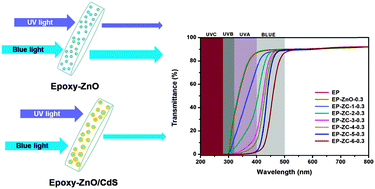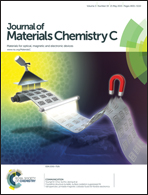Transparent epoxy–ZnO/CdS nanocomposites with tunable UV and blue light-shielding capabilities
Abstract
It is known that ultraviolet (UV) radiation is harmful to human health and affects the long-term stability of many organic materials. It has recently been discovered that blue radiation also poses a danger. In this study, epoxy–ZnO/CdS (EP–ZC) nanocomposites capable of shielding both UV and blue radiation were developed. First, ZnO/CdS nanoparticles were synthesized through the growth of CdS on prefabricated ZnO quantum dots (ZnO QDs). In contrast to ZnO QDs, which only absorb a portion of UV light, the ZnO/CdS nanoparticles exhibited strong absorption over the wavelength region extending from UV light to blue light. Further, their absorption-band range could be controlled by adjusting the Zn/Cd molar ratio. In situ polymerization was employed to prepare the EP–ZC nanocomposites, which were highly transparent at wavelength greater than 500 nm. It was found that the EP–ZC nanocomposites exhibited strong UV-shielding capability and could almost completely block UV light between 200–400 nm as well as more than 80% of the blue light between 400–450 nm when they contained 0.3 wt% ZnO/CdS nanoparticles. Finally, their optical transparency to visible light in the region beyond blue light was the same as that of pure epoxy due to the uniform dispersion of nanoparticles.


 Please wait while we load your content...
Please wait while we load your content...